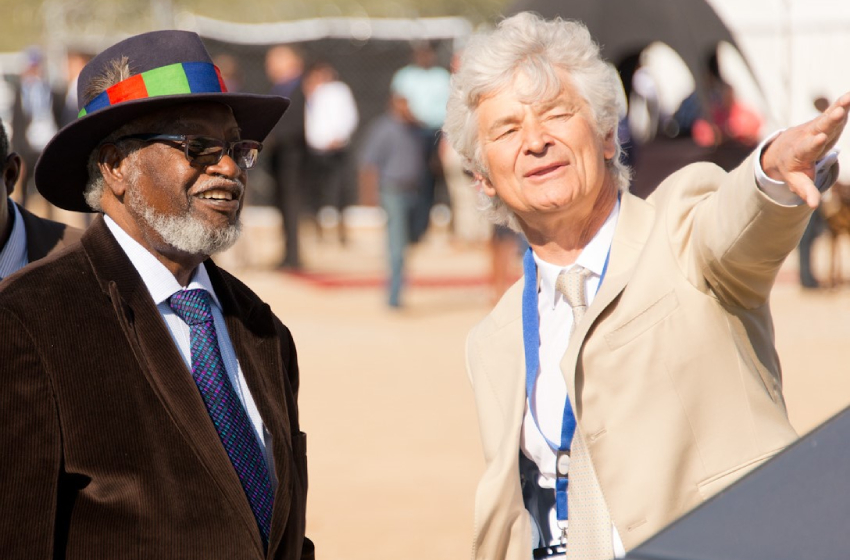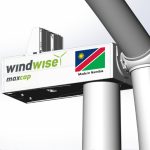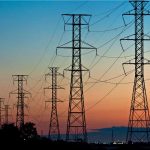The 4.5MW Omburu PV Plant, outside Omaruru, was inaugurated by the late Founding President Dr Sam Nujoma on 13 May 2015 and became the country’s first multi-million dollar solar power plant developed by an Independent Power Producer (IPP), InnoSun.
The inauguration of the Omburu solar power plant marked a historic milestone, not only for InnoSun but for the Namibian energy landscape. This was InnoSun’s first major project in the country, and it enabled the positioning of the company as a pioneer in the field of large-scale renewable energies.
InnoSun is the Namibian holding of InnoVent, the French renewable energy developer created in 2001 by Grégoire Verhaeghe. Verhaeghe was initially drawn to Namibia’s significant wind energy potential, which mirrors his experience in France where InnoVent built hundreds of MW of wind capacity. However, once in Namibia, he recognised the country’s exceptional solar irradiance among the highest in the world. That discovery led to a strategic shift toward solar energy.
Prior to the establishment of Omburu, renewable energy projects in Namibia had been limited to small-scale rooftop installations. Omburu demonstrated that it was technically and economically feasible to generate green power at a larger scale within the country, setting the stage for subsequent renewable investments.
The Omburu project was financed through a combination of local and international support. The Development Bank of Namibia (DBN) provided project financing, reflecting confidence in InnoSun’s business model and the project’s long-term sustainability. InnoVent contributed significant equity investment. This blend of local institutional backing and international technical expertise was instrumental in bringing the project to life.
FIRST NAMPOWER PPA WITH IPP
With the Omburu solar plant, InnoSun became the first local IPP to sign a power purchase agreement (PPA) with NamPower.
Usuta Imbili, Director of Omburu Sun Energy, a subsidiary of InnoSun, told Etango that the partnership with NamPower has developed considerably since the Omburu project.
“The trust established by this first PPA has created a solid foundation for future collaboration. Today, the InnoVent group of companies manages several PPAs with NamPower, including the Osona, Alcon and Camelthorn solar farms, as well as the Ombepo and Diaz wind farms. InnoSun will operate a total of 70 MW by the end of the year, with the commissioning of Sorexa and Diaz,” she said.
InnoSun has also been able to expand under the Modified Single-Buyer (MSB) model, with the upcoming commissioning of phase 1 (9.8 MW) of the Sorexa photovoltaic power plant, a 50 MW project designed to serve large energy consumers and export markets through the Southern African Power Pool (SAPP), in close collaboration with NamPower.
KEY PLAYERS
Several other partners were key in facilitating the Omburu project. IJG and Old Mutual Namibia were instrumental as financial investors: both have joined the Omburu shareholding post commissioning via different Government Institutions Pension Fund (GIPF) vehicles for a total stake of 40%, creating the ideal combination of national and international resources to optimise the plant.
“The Namibian Energy Regulatory Authority (ECB), NamPower, and the then Ministry of Mines and Energy also played crucial roles in enabling the licensing and regulatory approvals. Their collaboration and responsiveness were critical to the project’s timely execution,” said Imbili.
Since the launch of Omburu, InnoSun has gone to develop several renewable energy projects across Namibia, including solar and wind power installations.
“The upcoming commissioning of the Diaz (44 MW) and Sorexa (50 MW) power plants will take the company to the next level in terms of scale. It is important to note that InnoSun has created a joint venture with Black Diamond Investment (Pty) Ltd, a Namibian company run by women, which holds a 30% stake in InnoSun Energy Holdings. This partnership reflects InnoSun’s commitment to local empowerment, the inclusion of women and long-term collaboration to build a resilient green economy,” said Imbili.
At the inauguration of Omburu the then NamPower Managing Director Paulinus Shilamba said the solar power plant was a clear testimony that IPPs can work in Namibia. Since then, Namibia has seen substantial growth in IPP participation, and InnoSun is proud to have been part of that transformation.
Imbili said the work done with Omburu, in particular, inspired the interim Renewable Energy Feed In Tariff (REFIT) regime, which was a significant success and milestone for the sector.
“It validated efforts and demonstrated that public-private partnerships are essential to achieving national energy security and reducing dependence on imported electricity,” she said.
CHALLENGES FACED
Imbili acknowledged the challenges that InnoSun faced in developing the pioneering Omburu solar plant.
“At the start of the project, Namibia’s regulatory framework for renewable energies was still in its infancy. The National Integrated Resource Plan (NIRP) and Renewable Energy Policy were not yet finalised. Navigating land access, environmental compliance, and licensing was complex and required continuous engagement with regulators and stakeholders. Grégoire Verhaeghe’s experience in developing over 600MW of renewable energy projects in France and South Africa was a great help in guiding the strategy. One of the key lessons has been the importance of persistence, building trust with institutions, and aligning project goals with national development priorities,” said the Omburu Sun Energy Director.
The Omburu solar plant remains fully operational and continues to generate clean energy reliably. Since its inauguration on 13 May 2015, the plant has since delivered over 125 GWh of clean energy to the national grid. This is equivalent to powering over 4000 households per year. It has performed consistently over the past decade, delivering on all technical and contractual expectations.
The plant is under a 25-year PPA with NamPower, which means it still has approximately 15 years of active contribution to the national grid ahead, with regular maintenance ensuring optimal performance.
With rising electricity tariffs in Namibia, Imbili said renewable energy presents one of the most viable paths to long-term electricity price stability in Namibia.
“As technology costs continue to decline and scale increases, the cost of solar and wind generation is becoming increasingly competitive with imported electricity. InnoSun is committed to projects that offer predictable and affordable tariffs over time.
FLEXIBLE ENERGY TRADING
The introduction of the MSB framework is also enabling more flexible energy trading, which could ultimately benefit end-users (via Regional Electricity Distributors – REDs – for instance),” she said.
“While transmission and distribution costs remain a challenge, we believe that through continued investment and policy innovation, more Namibians—especially in rural areas—will gain access to affordable, clean energy in the coming years,” Imbili said. A critical component in achieving this goal, she said, is the continued effort in achieving cost-reflective tariffs. The ECB has emphasized the importance of setting tariffs that accurately reflect the true cost of electricity provision, including generation, transmission, and distribution expenses.






